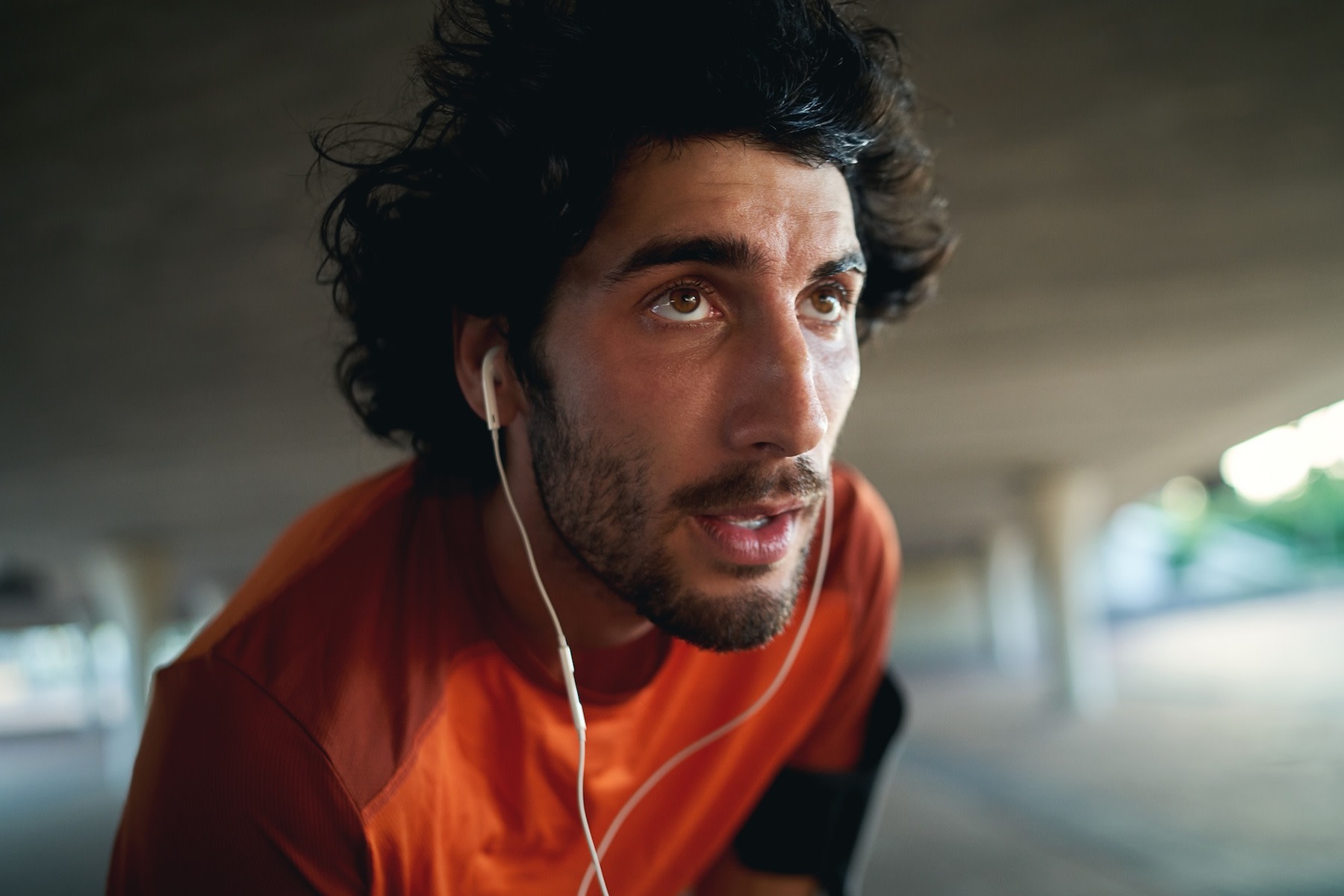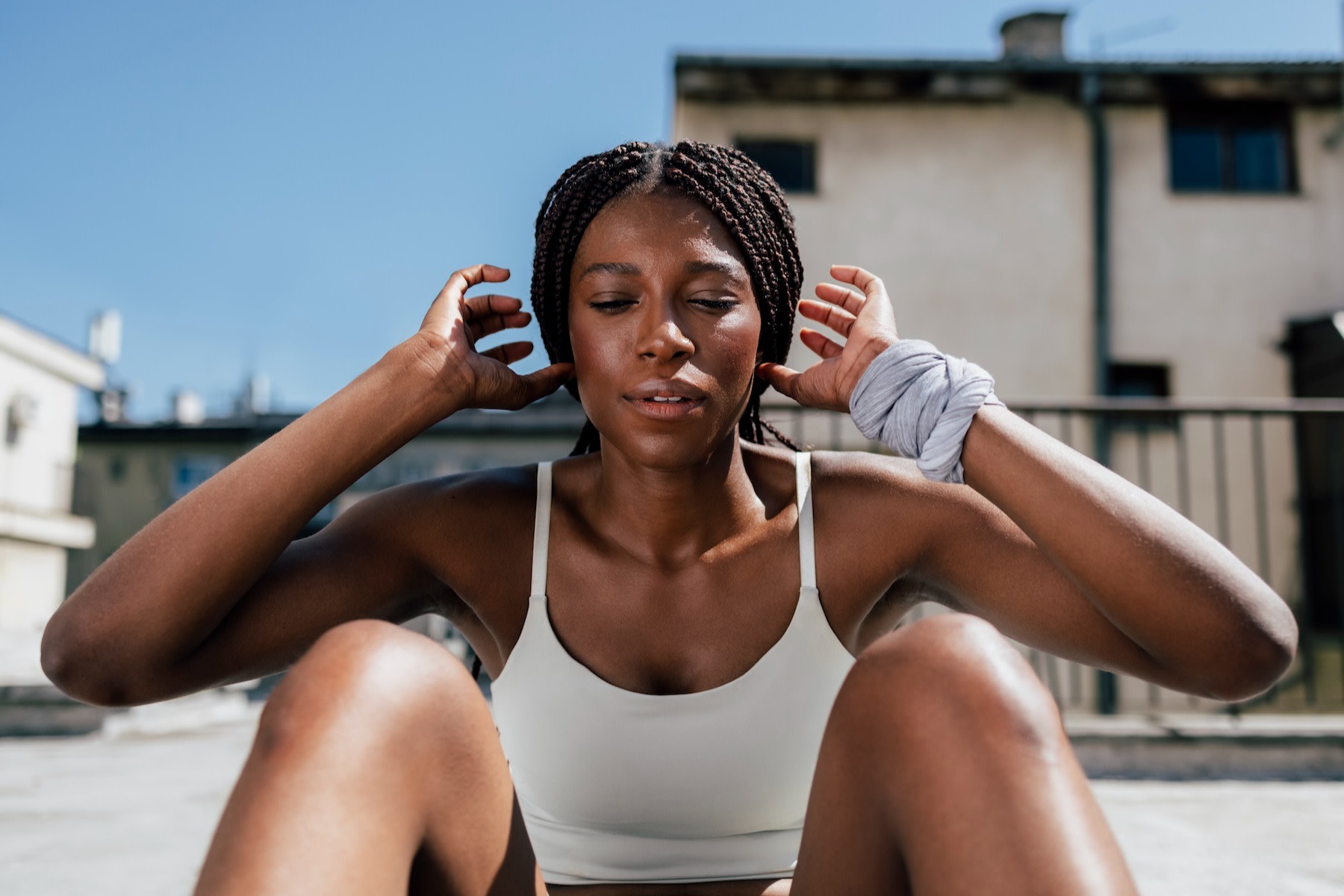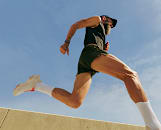
Lyndon Stratford / iStock / Getty Images Plus via Getty Images
Does Exercise Help or Hurt Acne? Here’s What to Know
On its own, exercise is good for your skin. But because excess sweat and tight fitness gear can lead to breakouts, there are a few post-workout skincare tips to remember for max benefit.
By Ondine Jean-Baptiste•
Does Exercise Help Acne?
Can Working Out Ever Lead to Acne?
How to Protect Your Skin Before, During, and After Exercise
The Takeaway
Picture this: You finish up a sweaty workout and immediately start knocking out other to-dos: commuting home, cooking dinner, hopping on a working call—you name it. A few hours go by until you’re able to hop in the shower, and before you know it, a crop of pimples has appeared on your skin. This is a frustratingly common occurrence for many of us—but does exercise itself actually cause acne?
Discover more ways to reach your goals with Peloton
The short answer is no, not directly. In fact, regular workouts can improve your skin over time. Sweaty conditions and poor hygiene before and after exercise on the other hand, can lead to unwelcome pimples across the face, chest, back, and butt.
Thankfully, there are a few steps you can take to safeguard your skin. We spoke with a dermatologist and an exercise physiologist to learn about how exercise helps acne, why some people might still break out after a workout, and how to keep post-workout acne at bay.
Does Exercise Help Acne?
Everyone is different, and how workouts impact acne will differ from person to person. But generally, there are several ways that regular exercise helps your skin.
It Reduces Inflammation
“Technically, exercise is a stressor,” says dermatologist Naana Boakye, MD. “But research shows [working out] specifically produces anti-inflammatory proteins called cytokines that help reduce inflammation.”
Acne is a chronic inflammatory condition. While cytokines in general can either boost or reduce inflammation in the body, physical exercise creates a cytokine called IL-6, which helps kickstart an anti-inflammatory response in the body.
It Increases Circulation
The positive effects of physical activity on vascular function have long been documented, but what does increased blood flow have to do with acne? “[Exercise] improves circulation, which helps deliver nutrients to the skin,” Dr. Boakye explains. The increase in blood flow also delivers more oxygen to skin cells and helps to clear out waste.
It Decreases Cortisol
Research shows that exercise can reduce baseline levels of cortisol in the body. This is a good thing for your skin, because stress hormones like cortisol “can trigger or worsen breakouts—especially hormone-related acne,” says exercise physiologist Cedric X. Bryant, PhD.
It Improves Sleep
Not only can exercise lead to reduced cortisol levels, it can also improve your sleep quality. (If you’ve ever gone to bed early after a tough workout, you know firsthand that physical activity can lead to a great night’s sleep.) And better Zzzs can translate to better skin: Bryant says that improved sleep leads to overall skin repair and reduces stress-related breakouts.
It Regulates Other Hormones Too
Exercise affects other hormones besides cortisol, which can have a positive impact on your skin health as well. Specifically, Bryant says that working out can help regulate hormones such as insulin and androgens that influence oil (sebum) production.
Here’s how it works: When insulin increases in the body, the amount of androgens go up, creating excess oil, according to the UW School of Medicine and Public Health. Too much oil production can cause clogged pores, irritated skin, and, you guessed it, a brand-new blemish. So by working out, you may help prevent those pimple-inducing insulin and androgen spikes.

Peloton App
Access thousands of classes with no equipment needed.
Can Working Out Ever Lead to Acne?
Clearly, there are several ways exercise helps improve acne. However, working out may create certain conditions that can clog pores and boost your risk of a breakout—namely, trapped sweat, tight clothing, or sub-par hygiene after exercise.
“Sweat-related pimples, technically called folliculitis, can form when sweat mixes with oil, bacteria, and dead skin, especially if left on the skin too long,” Bryant says. Tight workout gear such as sports bras, sweat bands, and helmets can also cause a type of acne known as “acne mechanica” from prolonged friction while exercising.
Even with the most loose-fitting of fitness apparel, sweat left sitting on top of your skin post-workout can be a recipe for a breakout (especially if you’re wearing makeup). This isn’t limited to the face, either—sweaty gym clothing left on too long can contribute to back and butt acne as well.
If this sounds familiar, don’t panic: There’s no need to avoid working out in the name of skin health. “It’s not the exercise that causes acne, but how you care for your skin before, during, and after activity,” Bryant says.
How to Protect Your Skin Before, During, and After Exercise
If you find that exercise irritates acne or leads to unwanted pimples, there are a few simple steps you can take to protect your skin from a post-workout breakout:
Avoid touching your face during workouts to reduce the spread of bacteria.
Wear clean workout clothing, ideally in breathable and moisture-wicking fabrics. When possible, try to avoid heavy or tight fabrics that may trap heat and sweat.
Shower as soon as possible after exercising. If washing off right after your workout isn’t possible, an antimicrobial cleansing wipe can go a long way.
Be gentle when you’re cleansing. Over-exfoliating or using a harsh face wash can disrupt the skin barrier and backfire, Dr. Boakye says. Rather, Bryant recommends using a gentle cleanser with ingredients such as salicylic acid or benzoyl peroxide to help reduce bacteria and inflammation—especially if you already feel a pimple coming on.
Use non-pore-clogging sunscreen or moisturizers, especially for outdoor activities. Specifically, Dr. Boakye suggests applying a lightweight, non-comedogenic moisturizer to support your skin barrier.
Wipe down gym equipment before use, and when in doubt, lay a clean towel as a physical barrier when needed.

miniseries / E+ via Getty Images
Already dealing with an exercise-induced breakout? Here are some expert-recommended tips to help it go away:
Remember: Avoid harsh scrubbing at the area. Abrasive movements can irritate the skin and make acne worse.
Apply spot treatments with ingredients like adapalene, benzoyl peroxide, salicylic acid, or other acne-fighting agents—so long as your dermatologist or healthcare provider gives you the OK for those treatments, of course.
Avoid picking at the area. As tempting as it is to squeeze, press, and pop a sweat pimple, it’ll likely make your skin worse and increase your risk of dark marks or scarring.
Remember that consistency and patience is key. It’ll typically take more than a couple days to see a marked improvement in your skin.
If breakouts persist or become severe, it’s best to speak with a dermatologist for personal treatment options.
The Takeaway
Exercise helps acne by reducing inflammation, regulating hormones, reducing stress, improving circulation, and boosting sleep. However, although movement itself doesn’t cause acne, some elements of exercise—such as tight clothing, increased friction, trapped sweat that sits on your skin, or poor post-workout hygiene—can lead to breakouts for some people, experts say. Fortunately, staying consistent with both your workout and skincare routines will help you avoid blemishes and promote skin health.
Related Articles

Health
Wondering Why Your Face Gets So Red When You Work Out? Dermatologists Explain What's Going On

Health
6 Benefits of Sweating That'll Make You Extra Thankful for That Post-Workout Glow

Health
Is Your Workout Wreaking Havoc on Your Skin? Here’s How to Treat and Prevent Sweat Pimples

Health
Always Sweaty After Your Post-Workout Shower? Here’s Why—and How to Prevent It
This content is for informational and educational purposes only and does not constitute individualized advice. It is not intended to replace professional medical evaluation, diagnosis, or treatment. Seek the advice of your physician for questions you may have regarding your health or a medical condition. If you are having a medical emergency, call your physician or 911 immediately.
Get our latest health stories straight to your inbox
Enter your email to get articles, expert-backed tips, and updates from Peloton sent to your inbox.
By providing your email address, you agree to receive marketing communications from Peloton.
For more about how we use your information, see our Privacy Policy.





